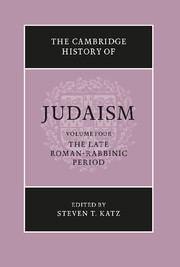Crossref Citations
This Book has been
cited by the following publications. This list is generated based on data provided by Crossref.
Laham Cohen, Rodrigo
1970.
El subordinado que subordina. Poseedores judíos de esclavos cristianos en el "Registrum" epistularum de Gregorio Magno.
Gerión. Revista de Historia Antigua,
Vol. 34,
Issue. ,
p.
325.
Lapin, Hayim
2010.
The Cambridge Guide to Jewish History, Religion, and Culture.
p.
58.
Mendels, Doron
2012.
The Encyclopedia of Ancient History.
Satlow, Michael L.
2012.
The Encyclopedia of Ancient History.
Avenarius, Martin
2012.
The Encyclopedia of Ancient History.
Amit, Aaron
2012.
The “Halakhic Kernel” as a Criterion for Dating Babylonian Aggadah: Bavli Ḥullin 110a–b and Parallels.
AJS Review,
Vol. 36,
Issue. 2,
p.
187.
Astren, Fred
2014.
A Companion to Mediterranean History.
p.
392.
Laham Cohen, Rodrigo
2017.
La confusión como estrategia retórica. María y Jesús enb Shabat104b yb Sanedrín67a.
Antiquité Tardive,
Vol. 24,
Issue. ,
p.
285.
Batuzov, Aleksei Anatol'evich
2019.
THE CELTS AND ROME: FORMATION AND FUNCTIONING OF CAESAR’S FIRST CELTIC LEGIONS.
Manuscript,
Vol. 12,
Issue. 11,
p.
72.
Bar-Asher Siegal, Michal
2019.
Jewish-Christian Dialogues on Scripture in Late Antiquity.
Everdell, William R.
2021.
The Evangelical Counter-Enlightenment.
Vol. 9,
Issue. ,
p.
283.
Alexander, Philip
2021.
The Cambridge Companion to the Apostolic Fathers.
p.
29.
Saputra, Brury E.
2022.
The Jewish background of the oneness language in John’s Gospel.
HTS Teologiese Studies / Theological Studies,
Vol. 78,
Issue. 4,
2022.
The Cambridge Companion to Antisemitism.
p.
23.
Piovanelli, Pierluigi
2022.
The Cambridge Companion to Antisemitism.
p.
57.
Perșa, Răzvan
2023.
The Image of Jews According to the Canonical Tradition of the Orthodox Church.
Religions,
Vol. 14,
Issue. 1,
p.
91.
Oro Hershtein, Lucas
2023.
Rethinking Jewish Theology.
Religions,
Vol. 14,
Issue. 3,
p.
364.





